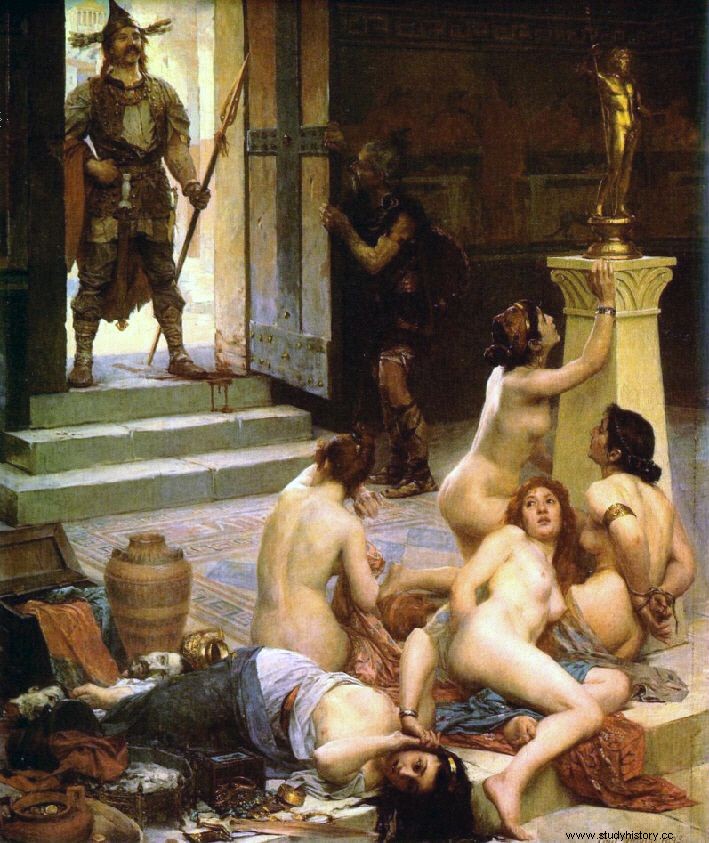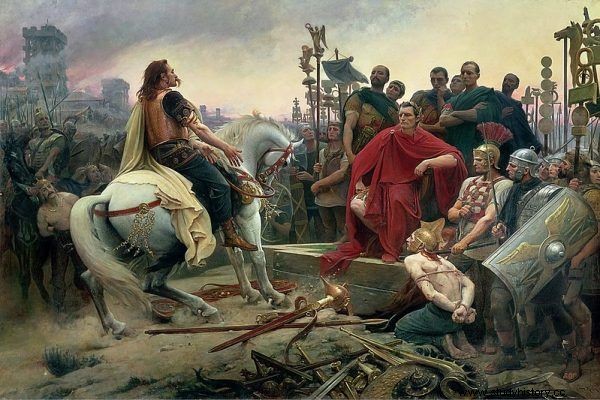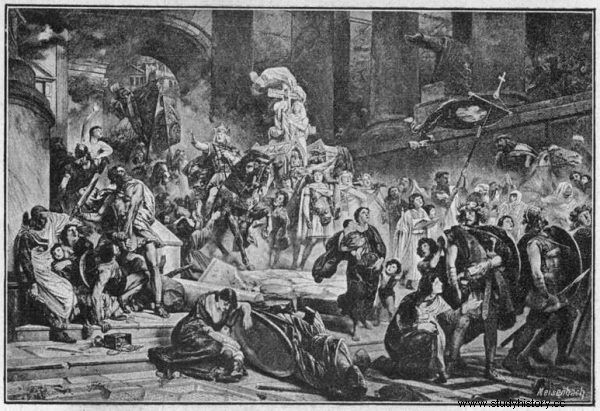During over a thousand years of history, Rome has fought countless wars. But only single chiefs were able to lead him to the brink of collapse. If they had succeeded, the history of the Roman Empire would have ended hundreds of years earlier. Or maybe even ... the Roman Empire would not have arisen at all.
Many powers appeared in the history of European civilization. They were born and fell, but none lasted longer than Rome, a country that emerged from successive wars and ultimately defeated them. Even before the legendary empire vanished, however, it had to contend with challenges from neighboring peoples from time to time.
This rivalry could end tragically for a rapidly developing republic. Who has almost succeeded in curbing its power?
5. Brennus
July 18, 387 B.C.E. he went down in the history of Rome thanks to Brennus, leader of the Celtic tribe of Senons. On that day, his troops crushed the Roman army near Alia, a tributary of the Tiber. As Aleksander Krawczuk writes in the "Chronicle of Ancient Rome", successive generations described this day as unfortunate. During it, no citizen was allowed to marry or make any sacrifices.
On July 21, Brennus entered the city without a fight and plundered it completely. The Gauls stayed in Rome for several months, during which they besieged the Capitol. Ultimately they didn't get it. The ravenous Romans hiding on the hill decided to pay the invaders a ransom in gold. The latter, satisfied with the loot, left the city uninterrupted by anyone.

Brennus managed to capture and sack Rome, but ultimately did not capture the Capitol.
Successive generations remembered these humiliating events with shame. No wonder that they were described differently by Polish chroniclers…
4. Hannibal
For many lovers of antiquity, the rivalry between Rome and Carthage remains one of the most entertaining episodes. The mutual anthoganism of both cities grew until the outbreak finally turned into a conflict lasting over a hundred years, lasting from 264 to 146 BC. The republic of the Apennine Peninsula, growing in power, emerged victorious from the clash.
Hannibal became the embodiment of the struggle of both countries. The actions and strategic genius of this commander at the turn of the 3rd and 2nd centuries BC almost led to the defeat of the Eternal City. The very march of his army of 50,000 infantry, 9,000 cavalry and 37 elephants through the Alps should be considered an extraordinary success. The commander broke into Italy, winning numerous victories in skirmishes with Roman troops. The Battle of Cannae from 216 BC is still considered a symbol of total victory to this day.
Hannibal failed to discount this win, however. The seventeen-year war, fought from 218 to 201 BC, gradually exhausted the combat capability of his troops. The Carthaginians, despite the humiliation inflicted on the enemy, did not manage to take Rome. Eventually they withdrew from Italy, and the legendary commander was forced by his fellow citizens to give up power. The Romans persecuted him for the rest of his life. The fear of being captured by them prompted him to commit suicide in 183 BC.
3. Vercingetorix
Another commander who challenged Rome was Vercingetorix, the 1st century BC commander of the Gallic tribe of the Arverni. Like Hannibal, he was characterized by remarkable cleverness and ruthlessness. He began his reign after his father's death in 52 BC. He focused his activities on the unification of Gallic tribes, which gave him a strong military base. Thus prepared, he launched a revolt against the Romans. During it, he became famous for his courageous, though cruel decisions. One of them decided that the Gauls would burn their own villages. This is what Gaius Julius Caesar, commanding the republic's troops, wrote about it in the Gallic War:
Vercingetorix, after so many successive defeats, [...] called his people to a conference. He explained for a long time that this war should be fought in different ways than before. First of all, one should strive to prevent the Romans from getting food and food. It is easy because the Gauls have enough cavalry and the time of the year is favorable to them.

Vercingetorix managed to unite the Gallic tribes against the Romans. However, he did not manage to win against Julius Caesar.
It is not allowed to mow the grass:enemies necessarily divided into small units will try to get supplies in the farms; riders can destroy them all daily. Accordingly, personal matters must be sacrificed for the general good:villages and farmsteads must burn down all the way from Boa in every direction where the Romans can presumably follow the forage.
In 52 BC, Vercingetorix encircled the Roman fortification in Alesia with an army reportedly numbering as many as 250,000 soldiers. He threatened the Roman lines in this way, but was unable to break them. In addition, he also exposed himself to tribesmen who, seeing the losses suffered in the campaign, were close to accusing him of treason. Eventually, he was released by them, and then, after several years of captivity, either executed or strangled. Caesar has won. However, the Gallic commander is mentioned in France to this day, as evidenced by the monuments in Clermont-Ferrand, Gien and Alesia.
2. Arminius
Decades after Vercingetorix's death, Rome faced another capable leader. This time, Arminius, the Germanic leader of the Cheruski tribe, stood against the growing power of the Eternal City. Interestingly, he was a… Roman citizen. He even fought as a lieutenant in the army of the empire.

Arminius turned against Rome, seeing the way the legions were acting in Germania.
Seeing the way the legions operated in his native Germany and wishing to restore dignity to its inhabitants, the talented commander decided to organize a revolt. He led a coalition of Germanic tribes and took the fight against the Roman governor of the province, Publius Quintilius Varus. In 9 AD, he defeated his troops in the Teutoburg Forest. There was a real massacre. Of the approximately twenty thousand legionnaires, only a dozen or so people managed to escape . Several hundred were captured. The rest died.
However, the spectacular success did not turn into a lasting victory. In the following years, Arminius had to face the troops commanded by Germanicus. In 16, he lost two battles, on the Weser River and on the Angryvarian embankment. After these events, the divided Germanic peoples began to gradually withdraw their military support. Finally, in 19 AD, the ambitious leader fell victim to a murder by his fellow tribesmen.
1. Alaric
The king of the Visigoths, Alaric, who lived at the turn of the 4th and 5th centuries, also brought with him the specter of the destruction of the Eternal City. Like Arminius, he was for a time an ally of Rome. He fought in the army of Emperor Theodosius. After the death of the latter, elected by his fellow tribesmen to be king, he broke the existing agreement and turned against the empire.

Alaric's capture of Rome, though temporary, heralded the fall of the empire.
The Visigothic troops achieved devastating success. Alaric was the first Germanic leader to enter Rome. It happened on August 24, 410. The city was plundered for three days. It fell for the first time in eight hundred years! It already heralded the fall of the empire.
The king, however, did not take advantage of his victory. He withdrew from Rome and headed south with the intention of transferring troops to Africa. The storm that destroyed the Visigoth fleet shattered this plan. Alaric himself soon died unexpectedly. Rome has survived again - but not for long.
Inspiration:
The article was inspired by the latest book by Ben Kane, entitled Hannibal. Enemy of Rome , which was released by the Znak Horyzont publishing house.
